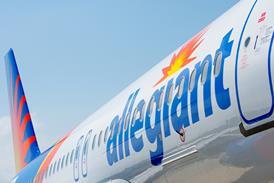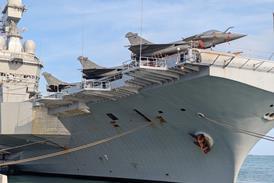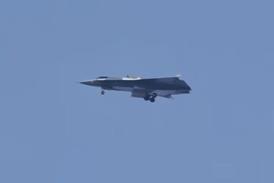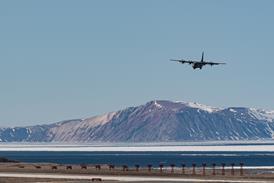On the eve of the Zhuhai air show, we look at China's growing market for aircraft and Western manufacturers' changing attitudes to co-operation
Western aircraft companies are increasingly outsourcing work to China to reduce costs and generate sales in a market that promises to be the world's second largest.
Prior to the 1980s, the only involvement Western companies had in China was selling aircraft into the market and providing product support. Boeing, for example, sold its first aircraft to Communist China in 1972, but only in the 1980s did it start outsourcing production of aircraft components to the country. Airbus signed its first contract for parts manufacturing in China in 1985, says Airbus China president Laurence Barron, adding that was the same year that Airbus delivered its first aircraft to China.
|
|---|
The Boeing 737's vertical fin, horizontal stabiliser and other parts of the empennage are made in China |
"The first parts that were sub-contracted were doors or door [components] and today a lot of doors, particularly on the Airbus A320 programme, are made in China," says Barron. The volume of work has increased and Barron says that China is now doing "more sophisticated and advanced work" for Airbus.
He cites the A320 wing programme as an example. China started by producing some wing parts, then it began producing the leading and trailing edges, and more recently secured a contract for the wing-box with first delivery due in 2007. Xian Aircraft does most of the work, followed by Shenyang Aircraft. Apart from the UK, China is the only country working on A320 wings, he adds.
Airframe contracts
Airbus also established an engineering centre in Beijing July last year. Barron says the centre will be designing Airbus A350 parts that will then be manufactured in China. "We are talking to Aviation Industry Corp [AVIC] I and AVIC II about sub-contracting to China up to 5% of the airframe work," he says, adding that the centre is doing work on the A320 and A340. AVIC I and II are Chinese state-owned aviation conglomerates that control China's aerospace companies.
Wade Cornelius, Boeing vice-president in charge of global strategy within the commercial aircraft division, says the work China is now doing for Boeing is "more complex and sophisticated" than what it was doing for the company in the 1980s.He adds: "We are in discussions with them about them taking on some of the design engineering responsibility and aligning that component with the manufacturing. That will allow them to take a greater level of control over their work statement and provide a better contribution to Boeing."
AVIC I companies currently produce the Boeing 737 vertical fin, horizontal stabiliser and parts of the empennage. "That work is distributed across about three of the AVIC I factories," says Cornelius. "The fourth factory, which is AVIC I's Chengdu Aircraft, produces doors on the 737 programme - and they now have a new contract to produce the Boeing 787's rudder."
Industrial co-operation
 |
|---|
"The work China is now doing for Boeing is more sophisticated than in the 1980s" Wade Cornelius, Boeing |
The new 787 programme resulted in Boeing forging relations with AVIC II. Cornelius says that AVIC II's "facility in Harbin is working with us to finalise plans to produce the wing-body fairings". He estimates the combined value of Boeing's contracts with AVIC I and II is $600 million.
According to Barron, Airbus anticipates that by year-end China will have contracts with the manufacturer totalling $60 million a year, and by 2010 the volume of work will rise to at least $120 million a year.
Some of the smaller aircraft manufacturers, Bombardier of Canada and Embraer of Brazil, also have industrial co-operation. In July, Bombardier announced it was shifting production of Dash 8 Q400 fuselages, doors and empennage to AVIC I's Shenyang Aircraft (SAC). SAC will deliver aft and forward Q400 fuselages to Bombardier, starting in 2008.
Japan's Mitsubishi Heavy Industries (MHI) had been producing the fuselages up to that point the Japanese firm was reportedly in favour of the move because it needed to make room for work it had secured on the 787 programme.
SAC already produces the doors for Dash 8 Q300, and Bombardier and SAC were planning to work together on the CSeries, Bombardier's new family of regional jet aircraft.
Although the CSeries programme has since been shelved, Chinese aerospace companies can rely on work from the Canadian aircraft manufacturer in future. Bombardier China president, Zhang Jianwei, declines to say which other aircraft parts the company is looking to outsource but he describes July's Q400 deal as the "first step". The company is "also looking for other possibilities, not just in terms of working with SAC but other aircraft manufacturers in China", says Zhang. He adds that Bombardier recently sent more than 70 SAC engineers and managers to its facilities in Montreal and Belfast for training under the Q400 fuselage co-operation programme.
Bombardier's major competitor in the regional jet market, Embraer, is involved in China through its joint venture with the Harbin Aircraft. Harbin Embraer has been assembling Embraer ERJ-145s since 2003, and is the only assembly plant outside Brazil assembling the aircraft type.
China has also secured substantial sub-contracting work from companies that supply parts and equipment to aircraft manufacturers, such as composite aircraft parts maker BHA (see box P36). Some of Boeing's suppliers in Japan are also looking to jump on the outsourcing bandwagon, even though political ties between the two neighbouring nations are less than sweet.
"The Japanese have been in discussions at this point with AVIC I facilities," says Boeing's Cornelius. "We have not seen them consummate any contracts yet, but there are discussions under way to look at taking on some subcontract work" for the 787 and 777, and Japan is considering China for the 777 because the production rate on the aircraft is increasing, he adds.
One clear reason Western aircraft companies and suppliers are outsourcing work to China is because of the country's low-cost base, although Barron at Airbus downplays the extent of the cost savings.
"Labour rates are cheaper, but don't forget that when you enter into a manufacturing programme in a different place, you have additional costs. For example you have to train people [and to] begin with, the production rate will be lower and less efficient than our own factories in Europe," he says.
Despite this, Airbus plans to establish an A320 assembly plant in Beijing's port city of Tianjin. Barron stresses that the proposal is subject to authorisation by the aircraft maker's board, but if approved it "is more likely" to be a joint venture than a wholly-owned business.
Import taxes
When asked if the aircraft assembled at the Chinese plant will avoid having to pay import duties, Barron declines to comment - even though the locally assembled Embraer ERJ-145s are exempt, and it could be argued the Harbin Embraer joint venture has set the precedent.
"All these details such as import taxes and duties are part of our feasibility study and discussions" with the Chinese authorities, says Barron. "These are all relevant issues but no one can answer them today because it would be premature," he adds, and any comment could be misconstrued as Airbus applying pressure to the Chinese.
|
|---|
Embraer's joint venture with Harbin has assembled ERJ-145s in China since 2003 |
Airbus's plan calls for Tianjin to start delivery of aircraft in 2008 and steadily increase production to four aircraft a month sometime around 2010. If the Tianjin plant is established, it could give the manufacturer a sales advantage over Boeing in China.
Embraer may already have gained such an advantage over its nearest rival, Bombardier. In August, China's Hainan Airlines ordered 50 Harbin Embraer ERJ-145s and 50 Brazilian-assembled Embraer 190s. It could be argued that Embraer secured this aircraft order because the ERJ-145 is assembled in China. But despite this recent sales success, there is no guarantee that having an assembly plant in China will lead to sales in that market. Prior to the Hainan Airlines deal, Harbin Embraer was struggling to secure enough orders to keep its assembly plant going.
There is also the case of McDonnell Douglas, which in the 1990s established an aircraft assembly plant in China with the help of AVIC I's Shanghai Aircraft. Under the so-called Trunkliner programme, dozens of MD-series narrowbodies were to have been produced in China.
But the programme ultimately failed: only two MD-90s were assembled there, because Chinese airline bosses felt that they were being forced to take on aircraft they did not want by the government.
Embraer's ERJ-145 assembly programme in China appears, for the moment, to have escaped failure. Embraer China managing director Guan Dongyuan says having an assembly plant in China allowed the Brazilian aircraft maker "to be different from competitors".
Guan adds that Embraer is considering a second phase of co-operation that involves outsourcing to China the manufacturing of some parts however, he declines to say which parts.
He does say that "if there is demand for this in the China market", the "third phase" of co-operation calls for Brazil and China "to work on a derivative of the ERJ-145". But this new derivative might only be sold in China, he adds. Currently, none of the ERJ-145s assembled in China are for export.
One major reason western aircraft companies are outsourcing work to China is that both recognise industrial co-operation with China is good for generating sales.
Boeing's Cornelius says: "We have never been so short-sighted as to think we could simply sell our products and services into China and not find ways for our Chinese partners to participate and have a bigger role. [It is] a good business equation for Boeing."
Airbus is "always looking for a win-win solution. The win for the Chinese side is getting work to occupy their factories and improve their ability. The win on our side [is] improved business prospects," says Barron, who estimates China accounted for one-fifth of Airbus' sales last year.
China's aviation market is forecast to overtake Japan and become the world's second-largest aviation market, after the USA. There is no doubt that the move to outsource work to China has helped make China's manufacturing processes world-class.
Chinese factories "are essentially using the same machines we use", says Barron. "They have state-of-the-art stuff and sometimes [have machines that are] more recent than our own. The machinery comes from all over the world - French machines, American, German and Italian machines."
Developing standards
Cornelius says that Boeing is a "strong proponent of sharing best practices", such as its lean manufacturing system. "Our competitors have found Chinese manufacturing to be a very attractive proposition, and it is largely due to the work Boeing has been doing over many years in China to help the Chinese develop their capabilities, competencies and quality standards."
|
|---|
|
Boeing owns 40% of composite panel maker BHA |
The Chinese have also developed some good technological capabilities, for example, in composite materials. "We were very impressed to learn the advanced capabilities the Chinese have in varied composites," says Cornelius.
"When we first did some additional source selection and review of existing capabilities, we discovered AVIC II in Harbin has excellent working capabilities with composites," he adds. "So it was not a matter of Boeing transferring any unique technologies in the area of composites materials processing", because it was already there in Harbin.
Barron says that he too is impressed with Harbin Aircraft's work on composites, although he suggests some of Harbin's expertise may have come from working for several years now with Airbus sister company Eurocopter. In July, Airbus signed a sub-contract with Harbin to do some composite work for A320s.
But is there a danger that outsourcing work to China means it will acquire the expertise to develop its own aircraft in competition against the West?
The Chinese have made no secret of their desire to build large commercial aircraft. China's state-run media revealed in January that the government plans to make the development and manufacture of commercial aircraft seating 150 or more a priority during the country's next five-year plan (starting in 2010).
China already manufactures small turboprop aircraft such as Xian Aircraft's 50-seat MA60. The MA60's European rival, ATR, claims that in recent years it has failed to secure aircraft orders in China because China's National Development and Reform Commission is trying to protect the MA60. China also has a 90-seat regional jet, the ARJ21, in development with first deliveries set for late 2009.
Airbus and Boeing, however, both downplay the threat of future competition from China. "We are not concerned about having to compete. We were born having to compete If we have to compete against others then so be it," says Barron.
"I think it is a definite possibility and it should be no surprise to anyone that China has the capability to [build a 150-seat commercial jet aircraft]," says Cornelius, but adds that "the requirements of a very demanding commercial customer base" are something the Chinese will have to overcome.
"Other companies may be able to demonstrate excellence in design and bring a product to market, but servicing and support is a whole other ball game," he says.
But the prospect of future competition from Chinese aircraft manufacturers that are also partnering with Western aircraft companies raises the thorny issue of intellectual property rights.
The US Commerce Department is already concerned about protecting US intellectual property (see box P38), and there have been historical instances where Western technology has surreptitiously made its way into China's indigenous aircraft programmes.
Built-in protection
China's 1970s-era Shanghai Y-10, for example, was a reverse-engineered design based on the Boeing 707. Some aerospace industry sources Flight International spoke to acknowledged that there are concerns over the issue of intellectual property infringement and, on the condition of anonymity, revealed some of the ways western aerospace companies are protecting intellectual property.
One strategy is to only give the Chinese work on aircraft nearing the end of the product's life cycle, so there is little benefit to appropriating the technology.
Another aerospace executive points-out that besides applying for patents and signing formal agreements, Western firms can protect intellectual property by limiting the amount of information and knowledge they share with Chinese industrial partners. "You can organise yourself in such a way that even if you are co-operating people don't have access to sensitive information," says the source.
Also, many of today's advanced technologies rely on software and software can be protected through encryption, adds another aerospace executive.
It could be argued that the best way to stay ahead of the competition, whether it be from China or some other emerging super power, is to invest heavily in research and development. As one Western aviation executive points out: "The best protection in this industry is to constantly invest in new technology. If you stand still, someone will catch you."
There are also those who argue that it is pointless to avoid co-operation with China just to protect intellectual property after all, they say, China has the capability to develop leading aviation technologies whether the West co-operates or not.
One aviation industry executive cites space technology as a prime example. China received no help from the USA or Europe with space technology but despite this, it has excelled in space technologies and today is one of the undisputed world leaders in the field.
The ZHuhai air show takes place from 31 October - 5 November. WWW.airshow.com.cn
Source: Flight International



























